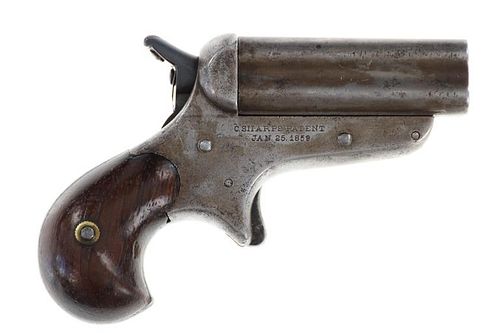This historic and important lot includes the C. Sharps four-barrel derringer circa 1859-1862 owned by Hunkpapa Sioux Chief Sitting Bull marked in Togia language as such as well as being marked with the Silent Eaters Society symbols. The firearm is a Christian Sharps Model 4B Pepperbox four-shot derringer pistol chambered in .32 RF (rimfire) with 2 ½ inch barrel, bird’s head grip frames, serial number of 10157, and marked on the side C. SHARPS PATENT JAN. 25, 1859.”
The pistol has been examined by Wendell Grangaard from The Guns of History, Inc., in Sioux Falls, South Dakota and was found to be marked in Lakota Togia language as follows: On the left side of the frame shows the Silent Eaters Society mark, Hunkpapa Sitting Bull, Sitting Bull / Slow, and One Bull (Illustration 1); the right side of the frame shows the Silent Eaters Society mark, Sitting Bull / Slow Hunkpapa, and One Bull mark again (Illustration 2); under the frame shows Slow / Sitting Bull, Silent Eater Society mark, Hunkpapa and One Bull (Illustration 3); under the frame near the serial number marked Sitting Bull / Slow (illustration 4); one the top of the barrel at the end of the left side is marked Sitting Bull / Slow (illustration 5); and on the back side of both the left and right of the grips marked Sitting Bull / Slow Hunkpapa, Silent Eaters mark (illustration 6). In the late 1960’s Wendell Grangaard met with David Bald Eagle, grandson to White Bull, on the Cheyenne River Reservation in South Dakota. White Bull was nephew of Sitting Bull and fought at Little Bighorn, David retold the stories handed down to him when he was a child, in the traditional manner. At this meeting David brought out a box and its contents which he inherited in 1947 after his grandfather and great uncle One Bull died. Inside the box Wendell asked about a fancy beaded bag he saw and David’s wife Josey noted it had a small derringer inside, Wendell noted this as being a Model 4B 4-barreled pistol with serial number of 10157. David Bald Eagle noted the ownership history as such: The firearm was part of the Sioux annual annuities in possession by Agent Samuel Latta in May 1862 at Fort Pierre who arrived there by steamboat. Agent Samuel Latta hosted a special gathering of the tribal chiefs aboard the steamboat on May 27th, 1862 with a feast and gift ceremony, the annuity payment being part of the treaty with the U.S. Government to stop the Sioux from attacking the whites on the “Holy Road”. At this time, on May 27th Sitting Bull received this Sharps 4-barreled derringer.
Later Sitting Bull’s mother, Her Holy Door, made him a bag to carry the pistol in. A drawing of the bag is included. The bag shows a red heart, representing the Strong Heart Society and inside the heart are the names of Sitting Bull in the language of Togia; these names were Sitting Bull, Slow and Jumping Bull. Below the red heart on the left in blue beads was the Silent Eaters symbol and on the right in white beads was White Horse Riders symbol. The black beaded crosses were Lakota Sioux symbols and the large black “W” represented the Hunkpapa. The symbol for Wakan Tanka / Paha Sapa was below the “W” in black beads and above the “W” was the symbol for the Thunder Being in black beads. The illustrations of the bag were made with the help of David Bald Eagle by Wendell Grangaard.
In December 1890 a Standing Rock Indian Agent, James McLaughlin ordered the arrest of Sitting Bull. Early in the morning of December 15, 1890, Sitting Bull was sleeping with his oldest wife, Seen By The Nations in their log home alongside the Grand River, south of the Wagon Road. They were awoken suddenly by Shaved Head, an Indian Police sergeant, who rushed in the door and shouted, “Brother – we have come for you!” Two policemen grabbed Sitting Bull, he was noted as trying to get something from under his bed, and took him outside into the cold night, being barely clothed. His wife, Seen By The Nations saw Sitting Bull looking under the bed and knew he was looking for his Sharps derringer, she wrapped it in a blanket and went outside. She tried to conceal the gun and give it to Sitting Bull and he shook his head saying “no”, so she put the gun in her pocket and wrapped him in the blanket. Sitting Bull yelled, “Let me go” and Seen By The Nations yelled, “What do you want of my husband.” Little Soldier, their son watched in shock. Just then Catch The Bear came running up with his Winchester rifle so Little Soldier rushed to protect his mother and pulled her away just before Catch The Bear started shooting at the policemen. They returned fire and Sitting Bull was killed by Red Tomahawk, along with many of their friends and guards being killed as well, including Catch The Bear. Little Soldier saw his mother start to pull at the derringer to shoot at the policemen as well, but he stopped her and took the gun from her. They went back and got the bag and brought both to give to One Bull later, One Bull was not there the day Sitting Bull was killed. They gave the gun to One Bull as he was also in the Silent Eater society.
Ownership Provenance: Agent Samuel Latta gave the gun in the annuity payment on May 27th 1862 and Sitting Bull received it. Sitting Bull kept it with him during his lifetime. He had it the day he was killed, his wife Seen By The Nations gave it to their son Little Solider, who in 1890 gave the pistol to One Bull. The information was handed down from One Bull, the great uncle, and White Bull, the grandfather, to David Bald Eagle. When both One Bull and White Bull died, the box including this gun were given to David Bald Eagle in 1947 and shown to Wendell Grangaard in the late 1960’s, as was the transmission of the history. Later Wenedell saw the gun come up for sale and purchased it, examining the piece and noting its Togia language markings.
This C. Sharps Model 4B is in well kept condition. The barrel slides out, the hammer pulls back, rotating the rim fire pin or mechanism to the next barrel. The spur trigger correctly releases the hammer. The hammer has two clicks. These Model 4A and 4B with the 2 ½ inch barrel clusters were commonly referred to as “Bull Dog” pepperboxes. The pistol is accompanied by the photograph illustrations, the drawn illustrations of the bag Sitting Bull kept the gun, and the written testimony and historical examination of the gun signed by Wendell Grangaard.
It should also be noted that at this meeting in the late 1960’s David Bald Eagle gave Wendell Grangaard a 32 RF shell from the gun as a present, which was also marked on the end in Togia, “Hunkpapa / Sitting Bull / Slow” as noted in Illustration 7. This bullet casing is in Grangaard’s personal collection. It should also be noted that David Bald Eagle stated that Sitting Bull carried the bag with the special derringer at his side thought most of his life, one could easily surmise that Sitting Bull then might have had this sidearm with him we he and Crazy Horse attached the U.S. 7th Cavalry at the Battle of the Little Bighorn, that to be said, this is not noted in the paperwork.
Sitting Bull attributed pieces are exceedingly rare with only a few pieces being brought to the public market such as the Winchester 1st Model 1876 taken from Sitting Bull’s cabin on December 15, 1890 and turned in to Standing Rock Reservation Indian Agent Major James McLaughlin (1842-1923) which sold at Cowans in June 2022 for $136,400 (shown w/ bp) from the Larry Ness collection and the Sioux Twisted Pipe Stem attributed to being owned by Sitting Bull from the Forrest Fenn collection sold by Hindman in June 2022 for $129,000 (shown w/ bp).
This is an Antique Firearm that does not require an FFL.


























